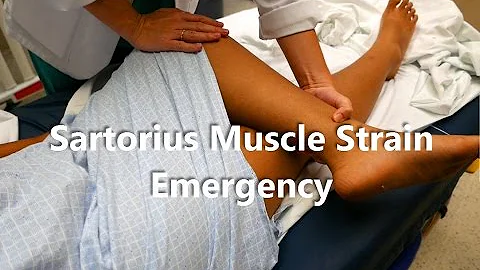What does sartorius pain feel like?
Most people with sartorius muscle pain feel a burning sensation down the front of their hip or tenderness on the inside of their knee.
Where do you feel sartorius pain?
Sartorius trigger points can refer pain along the muscle from the front of the hip and thigh down through the medial thigh and to the medial knee. They can also cause leg cramps, problems climbing stairs, and numbness and tingling in the outer thigh, known as meralgia paresthetica.

How do you relieve sartorius muscle pain?
Common treatments include a combination of anti-inflammatory medication to reduce pain and swelling, stretching exercises, icing the area affected, rest, and rehabilitation exercises.
How long does the sartorius muscle take to heal?
Rehabilitation should last from 20-30 days depending on the level and gravity of the strain. Prevention: stretching and ensuring of optimal m.
Can a tight sartorius cause hip pain?
For individuals who sit for long periods, tight hips and tight hip flexor muscles including the sartorius are common. As a result, hip pain or an uneven gait may occur. However, the anterior hip pain caused by a tight sartorius is often mistaken for issues with the psoas and iliacus.
How do you test your sartorius muscle?
We use 2 points of resistance we use this hand of the distal thigh to push into hip extension. And hip adduction. And we use this hand to resist external rotation so it will look like.
How do I know if I have sartorius?
Most people with sartorius muscle pain feel a burning sensation down the front of their hip or tenderness on the inside of their knee. Muscle strains happen when muscle or tendon fibers are overstretched or torn.
Why is sartorius called honeymoon muscle?
Which muscle is known as HONEYMOON muscle ? Daily Anatomy MCQ's forum for PG aspirants. Sartorius muscle is known as honeymoon muscle as it causes abduction and lateral rotation at hip …
How do you massage the sartorius?
So here we go to do the Sartorius. Attachment. You want to have the leg bent like this and you will find the ASIS.
What are the symptoms of torn sartorius?
Symptoms. Most people with sartorius muscle pain feel a burning sensation down the front of their hip or tenderness on the inside of their knee. Muscle strains happen when muscle or tendon fibers are overstretched or torn. Pain typically increases when people try to use the strained muscle.
How do you loosen a tight sartorius muscle?
And what you want to do is guide this knee down towards the floor to get that medial rotation and the hip to really stretch that Sartorius.
Why is my sartorius so tight?
Why Does the Sartorius Muscle Get Tight? As with many other soft tissues, the sartorius muscle can become tight either as a result of an acute muscle tear or through overuse, or perhaps due to long periods spent in a specific position.
How do you test the sartorius muscle?
We use 2 points of resistance we use this hand of the distal thigh to push into hip extension. And hip adduction. And we use this hand to resist external rotation so it will look like. This.
How do you fix a tight sartorius muscle?
To achieve a sartorius muscle stretch, find a position that combines the movements of hip extension, internal rotation and adduction. In a seated position turn your thigh inwards, pushing your hips forward, and pressing your knee to the ground.
How do you check for sartorius tightness?
Lie on a flat surface (a massage table works well). Extend the other with the but on the edge and the leg hanging over the edge. If you the leg hanging out is rotated outward but not away from the centreline (external rotation without hip abduction), then you might have tight sartorius muscles.
What is inflammation of sartorius muscle?
Pes anserine bursitis is a condition in which the medial portion of the knee is inflamed. If the bursa underlying the tendons of the sartorius, gracilis, and semitendinosus gets irritated from overuse or injury, a person can develop this ailment.
How do you release a tight sartorius muscle?
To achieve a sartorius muscle stretch, find a position that combines the movements of hip extension, internal rotation and adduction. In a seated position turn your thigh inwards, pushing your hips forward, and pressing your knee to the ground.
